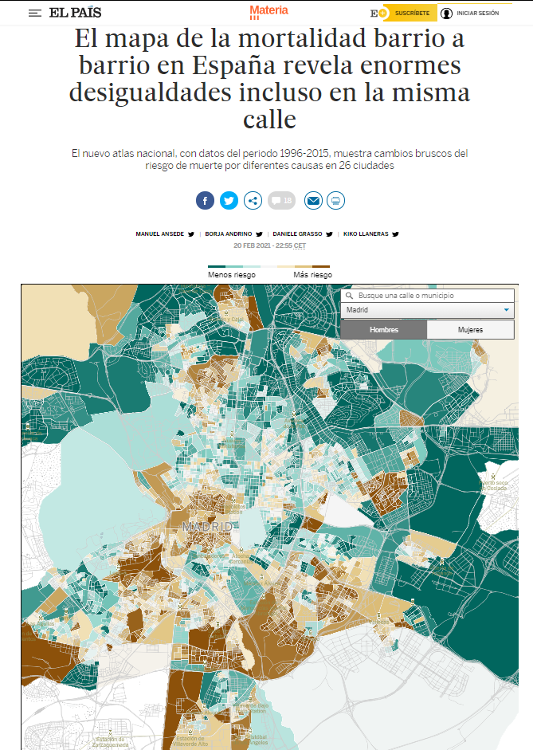
More and more media outlets have articles on their pages linked to so-called data journalism. This form of journalism uses the technologies and tools related to to data to provide readers with more documented, easier to understand and more engaging information.
In this article we explain what data journalism consists of and we show you some examples of media that already incorporate this modality within their informational processes.
What is data journalism?
Data journalism or data journalism is a journalistic discipline that incorporates different fields such as computer science, programming, engineering, statistics, design and journalism. to combine in the same space the analysis of data together with the narrative of the press. According to him Data Journalism Handbookdata can be the tool used to tell a story, the source a story is based on, or both.
Data journalism has its origin in Precision Journalism -evolution of investigative journalism-, where disciplines such as sociology and statistics are incorporated into traditional journalism, and Computer Assisted Journalism (Computer Assisted Reporting or CAR), which emerged in 1969 when journalists began to use computer systems to support them when dealing with the information they collected.
Data Journalism goes one step further and is the result of the digital transformation present today in the daily work of many newsrooms throughout the world. Using resources and tools related to data analytics, information is extracted from large databases. In this way, information of greater value and more complete is offered, adapted to the dynamism that digital reading requires.
What products does data journalism offer?
According to the digital magazine Journalists notebooks, there are at least four productions that can derive from this discipline, and that are generally complementary to each other:
- Data-driven articles: These are short articles that are made from large databases. These types of articles are typical of investigative journalism, since their common denominator is based on surveys or statistics.
- Applications news: The services that group information and send notifications to users about news of their interest from different media are becoming more and more common. For example, the main providers. For instance, Google Discover or Samsung Daily.
- Open datasets (datasets): Some media offer open data, the result of their research, in order to democratize information through the accessibility of data and its availability on the Internet in reusable and free formats. As an example, the New York Times offers data on the coronavirus openly.
- Interactive visualizations: such as infographics, graphics or applications that allow the information obtained from the databases to be viewed more clearly, facilitating the understanding of complex topics by readers. Visualizations can complement articles or be a product of their own when accompanied by short explanatory texts.
Data journalism in the media
More and more media have a news production based on data. Here are some examples:
At the national level
Among others, The country,The world or The newspaper They have a specific section within their digital newspapers dedicated to data journalism. Within both, newspapers address current affairs from the perspective offered by the data and through which they generate visualizations.like the following. In it, you can see a map that shows the inequalities in mortality according to the area in which you reside.

For its part, EpData is the platform created by Europa Press to facilitate the use of public data by journalists, with the aim ofboth to enrich the news with graphs and context analysis and to contrast the figures offered by the various sources. EpData also offers tools for creating and editing charts. An example of the activity they carry out is this article, where you can check the status of the dependency waiting lists in Spain.
Another example of data journalism is Newtral. It is an audiovisual content startup founded in 2018 in which data is the basis of all his work, especially in the fight against fake news. For instance, in this article different visualizations of data related to the oscillation of the price of light can be seen during different months.
On an international level
Data journalism is part of some of the most important international newspapers. It is the case of The Guardian, which also has a specific section dedicated to the production of journalistic material through articles, graphics and data-based visualizations. For instance, on this interactive map You can check which areas of Australia suffered the greatest natural disasters in 2020.
Another international media that also has a specific section for data-based journalism is the Argentine newspaper The nation, that through its section The Data Nation offers numerous informative productions in which it combines facts and news. For instance, in this article you can see an indicator of mobility of Argentine citizens.
Masters and studies related to data journalism
The digital transformation has meant that data journalism is here to stay. For this reason, more and more universities and education centers offer studies related to data journalism. For example, him Own Master's Degree in Data and Visualization Journalism from the University of Alcalá; the Master in Digital and Data Journalism taught by Atresmedia and the University of Nebrija or the Data Journalism Course from the UAM-El País School of Journalism.
In short, we are facing a modality with a future, which needs media that continue to bet on this discipline and professional capecesto handle data analysis and treatment tools, but also to tell stories, capable of transmitting what is happening in our environment with the support of data in a truthful and close way.
Therefore, it is not surprising that this form of journalism continues to grow in the coming years and that, in addition to the examples included in this article, the mass media and studies related to data journalism will increase. If you know any more and want to share it, do not hesitate to write to us contacto@datos.gob.es or leave us a message in the comments.
Content prepared by the datos.gob.es team.